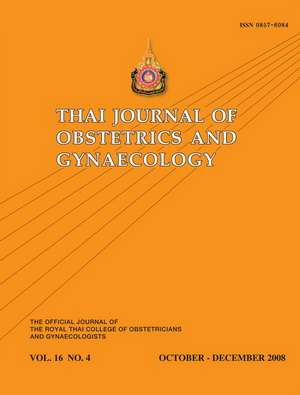A Randomized Double-Blind Controlled Trial Comparing Rapid Versus Stepwise Negative Pressure Application for Vacuum Extraction Assisted Vaginal Delivery
Main Article Content
Abstract
Objective: To compare efficacy and complication of a rapid (one-step) with stepwise
application of negative pressure for vacuum extraction.
Materials and Methods: All pregnant women laboring in Health Promotion Hospital, Bangkok
between October 1 st, 2002 to September 30th, 2007 were simple randomised to be assisted
by the rapid vacuum application (study group) or by the stepwise vacuum application
technique (control group). Each had the suitable conditions for vacuum assisted delivery.
Patients and obstetricians were blinded to the technique used. During the labour, the time
for vacuum application, traction, and delivery were recorded. The effectiveness of methods
of application, morbidity of mother and infant were evaluated by another doctor.
Results: Three hundred and seventy pregnant women were randomizedly studied. There
were no serious complications during or following the procedures in both groups. The both
technique were no significant difference in cup detachment rate, procedure failure rate, birth
passage injury, fetal injury, hyperbilirubinemia, breastfeeding failure, perineal pain after
delivery, perineal wound infection and postpartum haemorrhage. The mean decreasing
pressure time and traction time in study group (n=182) were 125.6 and 977.2 seconds
respectively. Meanwhile, in the control group (n=188), the mean decreasing pressure time
and traction time were 615.2 and 941.4 seconds respectively. The traction times were not
different (p=0.29), but the total procedure times in study group were less than in control
group (p<0.0001). The Apgar’s scores were not different between two groups,both at 1 st and
5th minute (p=0.04,0.16 respectively). For the fetus delivering with the indication of fetal
distress cases had less birth asphyxia in the study group than in control group (p<0.001)
The traction time of two birth asphyxia groups were not different (p=0.23) but the application
and total procedure time of both groups were significantly different (p<0.01, 0.01
respectively).
Conclusion: Rapid application of vacuum not only has the same efficiency and safety as
stepwise application but also be useful in the fetal distress cases because it has significantly
shorter time of a vacuum extraction.
application of negative pressure for vacuum extraction.
Materials and Methods: All pregnant women laboring in Health Promotion Hospital, Bangkok
between October 1 st, 2002 to September 30th, 2007 were simple randomised to be assisted
by the rapid vacuum application (study group) or by the stepwise vacuum application
technique (control group). Each had the suitable conditions for vacuum assisted delivery.
Patients and obstetricians were blinded to the technique used. During the labour, the time
for vacuum application, traction, and delivery were recorded. The effectiveness of methods
of application, morbidity of mother and infant were evaluated by another doctor.
Results: Three hundred and seventy pregnant women were randomizedly studied. There
were no serious complications during or following the procedures in both groups. The both
technique were no significant difference in cup detachment rate, procedure failure rate, birth
passage injury, fetal injury, hyperbilirubinemia, breastfeeding failure, perineal pain after
delivery, perineal wound infection and postpartum haemorrhage. The mean decreasing
pressure time and traction time in study group (n=182) were 125.6 and 977.2 seconds
respectively. Meanwhile, in the control group (n=188), the mean decreasing pressure time
and traction time were 615.2 and 941.4 seconds respectively. The traction times were not
different (p=0.29), but the total procedure times in study group were less than in control
group (p<0.0001). The Apgar’s scores were not different between two groups,both at 1 st and
5th minute (p=0.04,0.16 respectively). For the fetus delivering with the indication of fetal
distress cases had less birth asphyxia in the study group than in control group (p<0.001)
The traction time of two birth asphyxia groups were not different (p=0.23) but the application
and total procedure time of both groups were significantly different (p<0.01, 0.01
respectively).
Conclusion: Rapid application of vacuum not only has the same efficiency and safety as
stepwise application but also be useful in the fetal distress cases because it has significantly
shorter time of a vacuum extraction.
Article Details
How to Cite
(1)
Bounyasong, S. A Randomized Double-Blind Controlled Trial Comparing Rapid Versus Stepwise Negative Pressure Application for Vacuum Extraction Assisted Vaginal Delivery. Thai J Obstet Gynaecol 2017, 16, 206-213.
Section
Original Article


